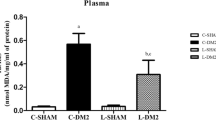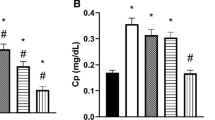Abstract
The main purpose of this study is to evaluate the effect of intravenous irradiation of different low-level laser wavelengths on the activity of lecithin-cholesterol acyltransferase (LCAT), paraoxonase (PON1), catalase, and ferric reducing ability of plasma (FRAP) in diabetic rats. First, diabetes was induced in rats using streptozotocin (STZ). Enzymes’ activity was measured in the blood samples and compared before and after intravenous laser blood irradiation. We used four continuous-wave lasers—IR (λ = 808 nm), Red (λ = 638 nm), Green (λ = 532 nm), and Blue (λ = 450 nm)—to compare the wavelength’s effect on different enzymes’ activity. Laser power was fixed at 0.01 mW and laser energy was changed by 2-, 4-, 6-, and 8-min time of radiations.
The enzymes’ activity of blood samples was measured 2, 6, and 24 h after radiation. The results show an increase in the activity of different enzymes when compare with diabetic non-radiated samples. More importantly, with a constant laser energy, the enzymes’ activity increased with decreasing laser wavelength. It is important to note that with a constant laser energy, as the wavelength decreases, the photon energy increases and the number of photons decrease, while the enzyme’s activity elevation increases. As a result, we can conclude that in intravenous low-level laser therapy, photon energy is more important than the number of photons even if their product, energy, is kept constant.





Similar content being viewed by others
References
Roelandts R (2002) The history of phototherapy: something new under the sun? J Am Acad Dermatol 46(6):926–930
Bagheri HS, Mousavi M, Rezabakhsh A, Rezaie J, Rasta SH, Nourazarian A, Avci ÇB, Tajalli H, Talebi M, Oryan A et al (2018) Low-level laser irradiation at a high power intensity increased human endothelial cell exosome secretion via Wnt signaling. Lasers Med Sci 33(5):1131–1145
Harding JJ (1991) Cataract: biochemistry, epidemiology and pharmacology. Chapman and Hall, London
Kappelle PJ, de Boer JF, Perton FG, Annema W, de Vries R, Dullaart RP, Tietge UJ (2012) Increased LCAT activity and hyperglycaemia decrease the anti-oxidative functionality of HDL. Eur J Clin Investig 42(5):487–495
Chance B, Sies H, Boveris A (1979) Hydroperoxide metabolism in mammalian organs. Physiol Rev 59(3):527–605
Feher J, Csomos G, Vereckei A (1987) Free radical reactions in medicine. Springer-Verlag, Berlin, Heidelberg
Pirart J (1978) Diabetes mellitus and its degenerative complications: a prospective study of 4,400 patients observed between 1947 and 1973. Diabetes Care 1(3):168–188
Brownlee M (1995) The pathological implications of protein glycation. Clin Invest Med 18(4):275–281
Sokolovic D, Djindjic B, Nikolic J, Bjelakovic G, Pavlovic D, Kocic G, Krstic D, Cvetkovic T, Pavlovic V (2008) Melatonin reduces oxidative stress induced by chronic exposure of microwave radiation from mobile phones in rat brain. J Radiat Res 49(6):579–586
Horikoshi S, Nakamura K, Kawaguchi M, Kondo J, Serpone N (2016) Effect of microwave radiation on the activity of catalase. Decomposition of hydrogen peroxide under microwave and conventional heating. RSC Adv 6(53):48237–48244
Sallam SM, Awad AM (2008) Effect of static magnetic field on the electrical properties and enzymes function of rat liver. Rom J Biophys 18(4):337–347
Vojisavljevic V, Pirogova E, Cosic I (2007) Influence of electromagnetic radiation on enzyme kinetics. In: 2007 29th Annual International Conference of the IEEE Engineering in Medicine and Biology Society, pp 5021–5024
Fedoseyeva G, Karu T, Lyapunova T, Pomoshnikova N, Meissel M (1988) The activation of yeast metabolism with He-Ne laser radiations-II. Activity of enzymes of oxidative and phosphorous metabolism. Lasers Life Sci 2:147–154
Silva Macedo R, Peres Leal M, Braga TT, Barioni ED, de Oliveira Duro S, Ratto Tempestini Horliana AC, Camara NOS, Marcourakis T, Farsky SHP, Lino-dos Santos-Franco A (2016) Photobiomodulation therapy decreases oxidative stress in the lung tissue after formaldehyde exposure: role of oxidant/antioxidant enzymes. Mediat Inflamm
Denadai AS, Aydos RD, Silva IS, Olmedo L, de Senna Cardoso BM, da Silva BAK, Carvalho P (2015) Acute effects of low-level laser therapy (660 nm) on oxidative stress levels in diabetic rats with skin wounds. J Exp Ther Oncol 11:85–89
Chen Y-P, Liu Y-J, Wang X-L, Ren Z-Y, Yue M (2005) Effect of microwave and He-Ne laser on enzyme activity and biophoton emission of Isatis indigotica Fort. J Integr Plant Biol 47(7):849–855
Chen H, Wang H, Li Y, Liu W, Wang C, Chen Z (2016) Biological effects of low-level laser irradiation on umbilical cord mesenchymal stem cells. AIP Adv 6(4):045018
Pillai PU, Padma N (1998) Studies on the effect of laser radiation and other mutagens on plants, Ph.D. thesis, Cochin University of Science And Technology
Simoes A, Ganzerla E, Yamaguti PM, de Paula Eduardo C, Nicolau J (2009) Effect of diode laser on enzymatic activity of parotid glands of diabetic rats. Lasers Med Sci 24(4):591–596
Ibuki FK, Simoes A, Nogueira FN (2010) Antioxidant enzymatic defense in salivary glands of streptozotocin-induced diabetic rats: a temporal study. Cell Biochem Funct 28(6):503–508
Simoes A, Nogueira FN, de Paula Eduardo C, Nicolau J (2010) Diode laser decreases the activity of catalase on submandibular glands of diabetic rats. Photomed Laser Surg 28(1):91–95
Sim ̃oes A, Siqueira WL, Lamers ML, Santos MF, de Paula Eduardo C, Nicolau J (2009) Laser phototherapy effect on protein metabolism parameters of rat salivary glands. Lasers Med Sci 24(2):202–208
Simoes A, de Oliveira E, Campos L, Nicolau J (2009) Ionic and histological studies of salivary glands in rats with diabetes and their glycemic state after laser irradiation. Photomed Laser Surg 27(6):877–883
Campos L, Nicolau J, Arana-Chavez VE, Sim ̃oes A (2014) Effect of laser phototherapy on enzymatic activity of salivary glands of hamsters treated with 5-fluorouracil. Photochem Photobiol 90(3):667–672
Da Silva NS, Potrich JW (2010) Effect of gaalas laser irradiation on enzyme activity. Photomed Laser Surg 28(3):431–434
Mirmiranpour H, Shams Nosrati F, Sobhani SO, Nazifi Takantape S, Amjadi A (2018) Effect of low level laser irradiation on the function of glycated catalase. J Lasers Med Sci 9(3):212–218
Tani S, Takahashi A, Nagao K, Hirayama A (2016) Association of lecithin–cholesterol acyltransferase activity measured as a serum cholesterol esterification rate and low-density lipoprotein heterogeneity with cardiovascular risk: a cross-sectional study. Heart Vessel 31(6):831–840
Wang X, Guo H, Li Y, Wang H, He J, Mu L, Hu Y, Ma J, Yan Y, Li S et al (2018) Interactions among genes involved in reverse cholesterol transport and in the response to environmental factors in dyslipidemia in subjects from the Xinjiang rural area. PLoS One 13(5):e0196042
Rousset X, Shamburek R, Vaisman B, Amar M, Remaley AT (2011) Lecithin cholesterol acyltransferase: an anti- or pro-atherogenic factor? Curr Atheroscler Rep 13(3):249–256
Nakhjavani M, Asgharani F, Khalilzadeh O, Esteghamati A, Ghaneei A, Morteza A, Anvari M (2011) Oxidized low-density lipoprotein is negatively correlated with lecithin-cholesterol acyltransferase activity in type 2 diabetes mellitus. Am J Med Sci 341(2):92–95
Calabresi L, Franceschini G (2010) Lecithin: cholesterol acyltransferase, high-density lipoproteins, and atheroprotection in humans. Trends Cardiovas Med 20(2):50–53
Ceron JJ, Tecles F, Tvarijonaviciute A (2014) Serum paraoxonase 1 (PON1) measurement: an update. BMC Vet Res 10(1):74
Litvinov D, Mahini H, Garelnabi M (2012) Antioxidant and anti-inflammatory role of paraoxonase 1: implication in arteriosclerosis diseases. N Am J Med Sci 4(11):523
Kowalska K, Socha E, Milnerowicz H (2015) The role of paraoxonase in cardiovascular diseases. Ann Clin Lab Sci 45(2):226–233
Aviram M, Rosenblat M, Bisgaier CL, Newton RS, Primo-Parmo SL, La Du BN (1998) Paraoxonase inhibits high-density lipoprotein oxidation and preserves its functions. A possible peroxidative role for paraoxonase. J Clin Invest 101(8):1581–1590
Camps J, Marsillach J, Joven J (2009) The paraoxonases: role in human diseases and methodological difficulties in measurement. Crit Rev Clin Lab Sci 46(2):83–106
Costa LG, Giordano G, Furlong CE (2011) Pharmacological and dietary modulators of paraoxonase 1 (PON1) activity and expression: the hunt goes on. Biochem Pharmacol 81(3):337–344
Mackness MI, Mackness B, Durrington PN (2002) Paraoxonase and coronary heart disease. Atheroscler Suppl 3(4):49–55
Scacchi R, Gambina G, Martini MC, Broggio E, Vilardo T, Corbo RM (2003) Different pattern of association of paraoxonase Gln192? Arg polymorphism with sporadic late-onset Alzheimer’s disease and coronary artery disease. Neurosci Lett 339(1):17–20
Hisalkar P, Patne A, Karnik A, Fawade M, Mumbare S (2012) Ferric reducing ability of plasma with lipid peroxidation in type 2 diabetes. Age (Yr) 42:8–70
Esteghamati A, Eskandari D, Mirmiranpour H, Noshad S, Mousavizadeh M, Hedayati M, Nakhjavani M (2013) Effects of metformin on markers of oxidative stress and antioxidant reserve in patients with newly diagnosed type 2 diabetes: a randomized clinical trial. Clin Nutr 32(2):179–185
Rad M, Rabizadeh S, Salehi S, Mirmiranpour H, Esteghamati A, Jafari R et al (2017) Advanced end glycation products, advanced oxidation protein products and ferritin reducing ability of plasma as markers of diabetic retinopathy. Austin J Endocrinol Diabetes 4(1):1057
Benzie IF, Strain JJ (1996) The ferric reducing ability of plasma (FRAP) as a measure of antioxidant power: the FRAP assay. Anal Biochem 239(1):70–76
Acknowledgments
Lasers were supplied by International Faran Tech Co. We thank Miss Salile Khandani and Miss Nafise Goli for their help. Special thanks to Dr. Marjaneh Hejazi for fruitful discussion.
Funding
This project was supported by Sharif Applied Physics research centre at Sharif University of Technology.
Author information
Authors and Affiliations
Corresponding author
Ethics declarations
Ethical considerations
The study protocol was approved by the animal ethics review committee, in accordance with the guidelines for the care and use of laboratory animals prepared by Tehran University. Informed consent of this investigation has been ordered by Medical Physics and Laser Lab of Physic Department at Sharif University of Technology.
Additional information
Publisher’s note
Springer Nature remains neutral with regard to jurisdictional claims in published maps and institutional affiliations.
Rights and permissions
About this article
Cite this article
Amjadi, A., Mirmiranpour, H., Sobhani, S.O. et al. Intravenous laser wavelength radiation effect on LCAT, PON1, catalase, and FRAP in diabetic rats. Lasers Med Sci 35, 131–138 (2020). https://doi.org/10.1007/s10103-019-02805-5
Received:
Accepted:
Published:
Issue Date:
DOI: https://doi.org/10.1007/s10103-019-02805-5




